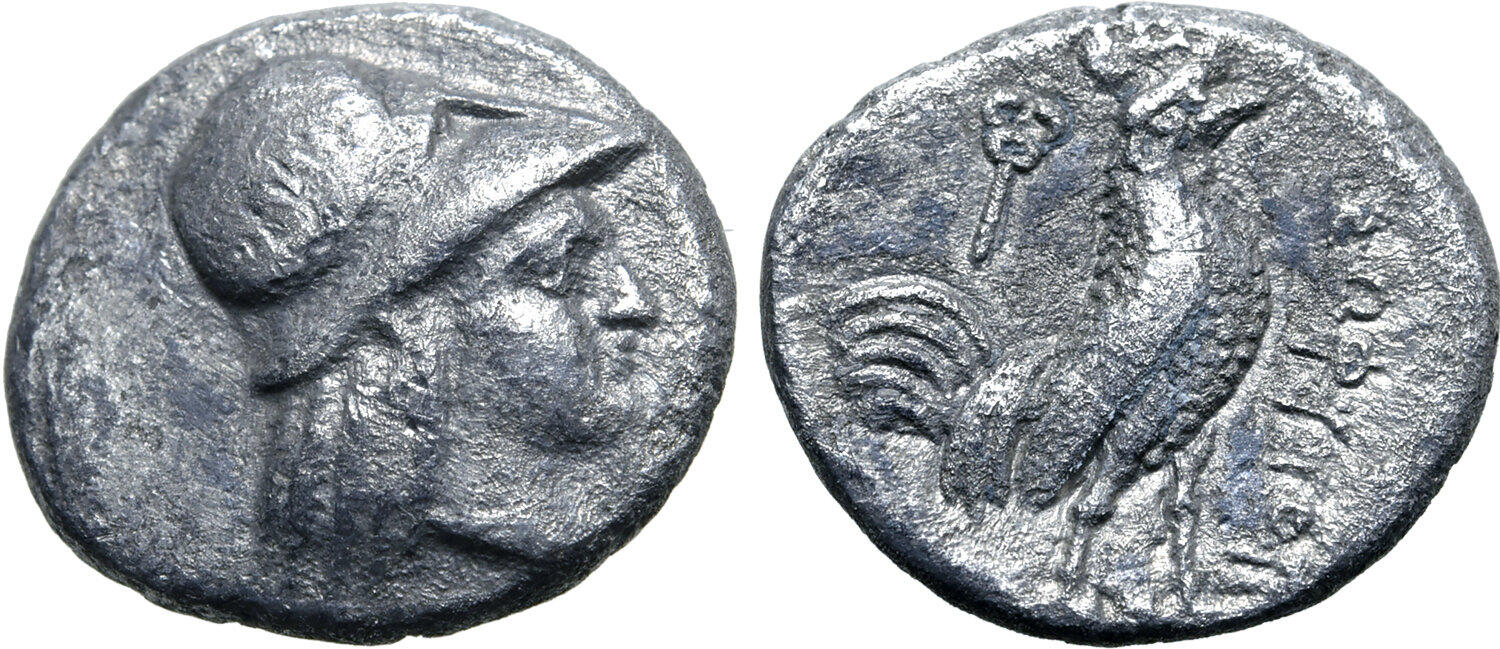S 1904 - Oxus (uncertain mint) (Sophytes), silver, diobols (246-235 BCE)
From SILVER
246 BCE - 235 BCE Silver 569 kg
Description
| ObverseInscription or printing placed on the obverse.: | Head of Athena to right, wearing Corinthian helmet |
| ReverseInscription or printing placed on the reverse.: | ΣΩΦYΤΟΥ to right (Greek).Cockerel standing to right, with wings closed, kerykeion behind |
Mint and issuing power
| MintIdentifies the place of manufacture or issue of a numismatic object.: | Oxus (uncertain mint) | Ancient regionAncient region.: | Bactria | Modern countryModern country: Afghanistan | AuthorityIdentifies the issuing power. The authority can be "pretended" when the name or the portrait of X is on the coin but he/she was not the issuing power. It can also be "uncertain" when there is no mention of X on the coin but he/she was the issuing power according to the historical sources: | Sophytes, Bactrian Kingdom |
Chronology
| FromIdentifies the initial date in a range assigned in a numismatic context. | 246 BCE | toIdentifies the final date in a range assigned in a numismatic context.. | 235 BCE | PeriodTime period of the numismatic object.: Classical 480-323 BC |
Physical description
| MetalThe physical material (usually metal) from which an object is made.: | Silver |
Median weightMedian of the weights of numismatic objects (in grams). in grams | 1.00 | DenominationTerm indicating the value of a numismatic object. Examples: tetradrachm, chalkous, denarius.: | diobol |
StandardStandard.: |
Image

S1904 Sophytes diobol Athena.jpg [1]
References
| Die study referencePublication of the study: | Jansari 20181Jansari 2018, p. 94 | ||
| Coin series referenceReference to coin series study: | HGC 122HGC 12, n° 16 | ||
Obverse dies distribution
Reverse dies distribution
no distribution is available
Quantification
| Number of obversesNumber of obverse dies. ᵖ (o) | 9 | Number of singletons (o1)The number of singleton coins. ᵖ | 7 |
| Number of reverse diesNumber of reverse dies. (r) | 0 | Number of coinsNumber of coins. (n) | 12 |
| Coins per obverse dieNumber of coins per obverse die. (n/o) | 1.33 | Coins per reverse dieNumber of coins per reverse die. (n/r) | |
| Reverse per obverse ratioRatio of obverse dies divided by reverse dies. (r/o) | 0 | Percentage of singletons (o1)number of coins (n) divided by the number of singletons (o1) ᵖ | 77.78 % |
| Original number of dies (O) (Carter 1983 formula)The estimation of the number of coins according to Carter 1983 ᵖ | 28.46 | Coins struck if 20,000 as average productivity per dieCoins made if the average productivity for obverses (according to Carter) is 20,000. ᵖ | 569,200 |
| Original number of dies (O) (Esty 2011 formula)The estimation of the number of coins according to the singleton formula in Esty 2011 ᵖ (O) | 36 | Survival rate if 20,000 as average productivity per dieSurvival rate if average productivity is 20,000. ᵖ | 0.00002 |
| Coverage (o = % of O) (Esty 1984 formula)Esty 1984 - coverage (% of O) ᵖ (o = % of O) | 41.67% | Die productivity if survival rate 1/2,000Average productivity if survival rate is 1/2,000. ᵖ | 843.29 |
| Weight of silver (in kg) if 20,000 coins per die (O = Carter formula)Carter 1983 * Median weight * 20000 (*10 if gold or electrum) ᵖ | 569 kg <br /> 569 kg | Die productivity if survival rate 1/5,000Average productivity if survival rate is 1/5,000. ᵖ | 2,108.22 |
Remarks
Most likely one single workstation
References
- ^ Jansari, Sushma (2018), "The Sophytes Coins: from the Punjab to Bactria and back again", Numismatic Chronicle, 178, p. 71-98.
- ^ Hoover, Oliver D. (2013), Handbook of coins of Baktria and ancient India : including Sogdiana, Margiana, Areia, and the Indo-Greek, Indo-Skythian, and native Indian states south of the Hindu Kush, fifth century BC to first century, Lancaster-London,